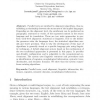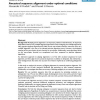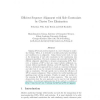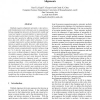CPHYSICS
2011
13 years 8 months ago
2011
The inner silicon detector of the Compact Muon Solenoid experiment (CMS) at CERN’s LHC consists of 16 588 modules. Charged-particle tracks in the detector are used to improve th...
BMCBI
2011
2011
Smith-Waterman Peak Alignment for Comprehensive Two-dimensional Gas Chromatography Mass Spectrometry
13 years 8 months ago
Background: Comprehensive two-dimensional gas chromatography coupled with mass spectrometry (GC × GCMS) is a powerful technique which has gained increasing attention over the las...
BMCBI
2011
13 years 8 months ago
2011
Background: Pairwise sequence alignment methods are widely used in biological research. The increasing number of sequences is perceived as one of the upcoming challenges for seque...
CIARP
2009
Springer
14 years 2 months ago
2009
Springer
Abstract. Parallel texts are enriched by alignment algorithms, thus establishing a relationship between the structures of the implied languages. Depending on the alignment level, t...
BMCBI
2005
14 years 4 months ago
2005
Background: Multiple genome alignment is an important problem in bioinformatics. An important subproblem used by many multiple alignment approaches is that of aligning two multipl...
CONSTRAINTS
2008
14 years 4 months ago
2008
Aligning DNA and protein sequences is a core technique in molecular biology. Often, it is desirable to include partial prior knowledge and conditions in an alignment. Going beyond...
BMCBI
2010
14 years 4 months ago
2010
Background: Proteins show a great variety of 3D conformations, which can be used to infer their evolutionary relationship and to classify them into more general groups; therefore ...
DIAL
2004
IEEE
14 years 8 months ago
2004
IEEE
Today's digital libraries increasingly include not only printed text but also scanned handwritten pages and other multimedia material. There are, however, few tools available...
WABI
2004
Springer
14 years 9 months ago
2004
Springer
Abstract. Sequence alignment algorithms have a long standing tradition in bioinformatics. In this paper, we formulate an extension to existing local alignment algorithms: local ali...
SSDBM
2006
IEEE
14 years 10 months ago
2006
IEEE
Multiple sequence alignment represents a class of powerful bioinformatics tools with many uses in computational biology ranging from discovery of characteristic motifs and conserv...




